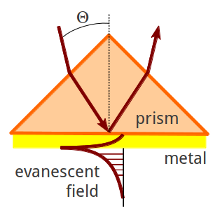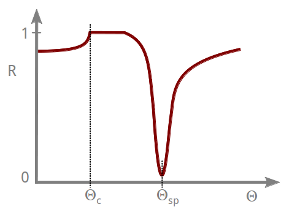Theory - Links
Confocal vs evanescent
Principles of evanescent illumination
Surface plasmons
Label-free detection
Surface plasmon fluorescence spectroscopy
Optical waveguide spectroscopy
Excitation of surface plasmons
 If a thin nobel metal layer (e.g. silver or gold) is evaporated onto the base of the prism, so-called “surface plasmon polaritons” (propagating electromagnetic waves at the interface of the metal and the dielectric material that is in contact with the metal) are excited at a distinct resonance frequency, i.e. a distinct incidence angle of reflection
If a thin nobel metal layer (e.g. silver or gold) is evaporated onto the base of the prism, so-called “surface plasmon polaritons” (propagating electromagnetic waves at the interface of the metal and the dielectric material that is in contact with the metal) are excited at a distinct resonance frequency, i.e. a distinct incidence angle of reflection ![]() .
.
Surface plasmons are short range phenomena, which can be regarded as an enhanced electromagnetic field that propagates along the interface with high attenuation. Surface plasmons can only be excited by the use of p-polarized light. The latter is determined by the optical thickness of the metal layer, i.e. the product n(metal) * d(metal), with n(metal) being the refractive index, and d(metal) the thickness of the metal layer, respectively.

If now angular scans of the reflectivity are measured, the surface plasmons are observed as a minimum in the reflected light at ![]() (see Figure). From such surface plasmon spectra, the optical thickness can be obtained by model fit calculations.
(see Figure). From such surface plasmon spectra, the optical thickness can be obtained by model fit calculations.
